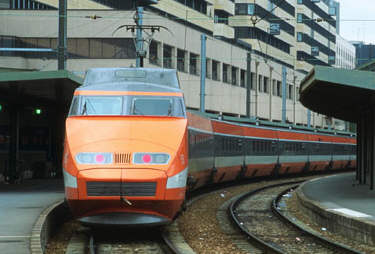|
|
Why destroyed ? |
|
Oil crisisIn October 1973, members of OPEC proclaimed an
oil embargo and it lasted until March 1974. This event is known as 1973
oil crisis and oil prices rose steeply. In such a circumstance, gas
turbines were began to be avoided due to their high fuel consumption and
high speed rail projects using turbine powered train were all
reconsidered. Advancement in electric drive Many advancement were achieved in the
field of power electronics which enabled adjustable voltage, adjustable
frequency control method. And also advanced technology was established
for providing with electricity from an overhead
wire. These technologies enabled high speed trains over 300km/h cruising
speed with high efficiency.
Delay of the turbine technology revolutionIn those days, turbines were thought to be the most revolutionary technology among internal combustion engines. But the revolution was not become real. High temperature, high flexural strength ceramics were hoped for, but could not be produced in commercial scale and price. High efficient gas turbines were dreams of car industries but could not be realized. Progress in diesel technologyThe diesel technology was advanced slowly but
steadily. High volume and mass problems of this engine were gradually reduced Thus, any high speed rail was planned upon assumptions that the high speed train's power source was electricity and middle speed diesel.
|


 .
Originally fuel consumption of diesel was low and modern direct
injection and electronic technologies improved its efficiency more.
Thus, diesels had become the only power source in non-electrified lines
and extended their area of activity to a semi-high speed rail. Intercity
125 (HST) was the first non-electrified 200km/h commercial service
started in Britain in 1976.
.
Originally fuel consumption of diesel was low and modern direct
injection and electronic technologies improved its efficiency more.
Thus, diesels had become the only power source in non-electrified lines
and extended their area of activity to a semi-high speed rail. Intercity
125 (HST) was the first non-electrified 200km/h commercial service
started in Britain in 1976.